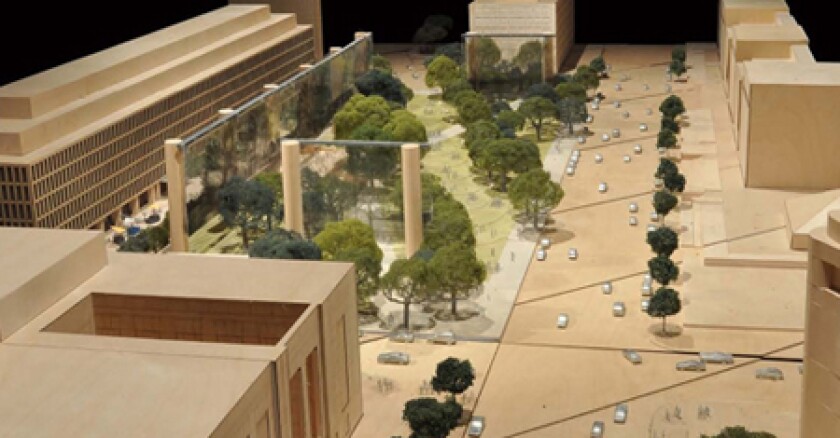A Congressional subcommittee hearing held Tuesday morning was the latest development in the ongoing conflict over the memorial, which is being designed by Frank Gehry and will be positioned behind Smithsonian National Air and Space Museum, just off the National Mall.
Susan Eisenhower, one of Dwight's granddaughters, called on the committee overseeing the memorial to return to the drawing board. She called for a simpler memorial that more clearly tells the story of her grandfather's life.
View Eisenhower Memorial in a larger map
Gehry’s memorial design features a series of massive columns, large metallic screens depicting images of Eisenhower’s native Kansas, bas reliefs of Eisenhower as both president and general, and even a smartphone component complete with augmented reality technology. At the center of it all is a statute of Eisenhower as a boy, designed to highlight his humble roots. Critics who testified said that by combining so many different elements into the memorial, the important message about Eisenhower and his accomplishments will be lost.
Susan Eisenhower says her grandfather “is not a dreamy boy but a real man who faced unthinkable choices, took personal responsibility, and did his duty with modesty and humility.”
“We now believe that a redesign will be the only way to make this memorial acceptable to the American people,” she said. Another granddaughter, Anne Eisenhower, also criticized the design.
Gehry's supporters say the architect is completely redefining the concept of memorials and believe he is sending a powerful message by noting the humble roots of a man who grew to accomplish to much.
The hearing was an atypical one for Congress, which usually doesn't weigh in on artistic matters. Gehry's initial design concept for the memorial was accepted by a federal commission two years ago, but criticism of the unorthodox plans only started generating headlines in recent months as the design has progressed and gained more publicity. “It’s a very unusual hearing,” said Rep. Raúl Grijalva (D-Ariz.), noting that federal lawmakers may be viewed as micro-managers by inserting themselves into the process. Already, some congressmen have expressed their desire to halt the project in its current form.
Critics speaking at the hearing noted that the process that resulted in Gehry's selection wasn't an open design competition, and they suggested the memorial's leaders knew from the start that they wanted Gehry for the job. Gehry was named a finalist for the project before he even submitted a design.
Carl Reddel, executive director of the commission, conceded that the selection process favored large, established designers and would make it difficult for an unknown designer to break it. Maya Lin, who designed Washington's iconic Vietnam Veterans Memorial, famously made her submission as a college undergraduate student in 1981.
Despite the calls to scrap the design, it may be too late to start over. Doing so would delay the project by two years and mean $16 million spent so far have been wasted, Reddel said. The project is slated to open Memorial Day 2015.









